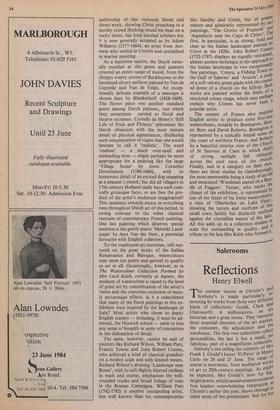Art
Off-beat
David Wakefield
The Watercolour Collection Formed by Mrs Cecil Keith (Agnew till 25 May)
The Alan Jacobs Gallery (8 Duke Street, SW1) displays a collection of Dutch and Flemish 12th-century paintings — The Timeless Moment ___ until the middle of June. This interesting sample of works con- tains several relatively obscure and un- familiar names. The exhibition is headed by an intriguing painting of 'Christ Preaching on the Sea of Galilee' from the Bowes Museum in County Durham, formed by John and Josephine Bowes in the mid-19th century; it clearly illustrates the adven- turous and frequently off-beat tastes of those pioneer collectors. It also comes as a refreshing change from the standardised pursuit of the 'great names' of art — now common policy among public and private collectors. No such considerations as com- mittees, tax concessions or the 'heritage' (all of which bedevil the buying and selling of works of art in modern times) hampered John Bowes when he bought 'Christ Preaching on the Sea of Galilee'. The
authorship of this curiously literal and direct work, showing Christ preaching to a motley crowd flocking round his boat on a rocky shore, has long puzzled scholars but it is now generally accepted as by Adam Willaerts (1577-1664), an artist from Ant- werp who settled in Utrecht and specialised in marine painting.
As a maritime nation, the Dutch natur- ally excelled at this genre and painters covered an entire range of mood, from the choppy wintry storms of Backhuysen to the becalmed silvery surfaces painted by Van de Cappelle and Van de Velde. An excep- tionally delicate example of a seascape is shown here by Blankerhoff (1628-1669). The flower piece was another standard genre among Dutch painters, one which they sometimes carried to florid and bizarre extremes. Cornelis de Heem's 'Still Life of Fruit and Flowers' epitomises the Dutch obsession with the most minute detail of physical appearances, displaying such concentration of vision that one would hesitate to call it 'realistic'. The word 'realism' — a much over-used and misleading term — might perhaps be more appropriate for a painting like the large 'Village Scene' by Joost Cornelisz Droochsloot (1586-1666), with its humorous detail of an excited dog snapping at a peasant's smock; but did all villagers in 17th-century Holland really have such com- ically grotesque faces, or are they the pro- duct of the artist's exuberant imagination? This tendency towards excess in everything runs throughout Dutch art of this period, in strong contrast to the sober classical restraint of contemporary French painting. One last painting which deserves special mention is the gently poetic 'Moonlit Land- scape' by Aert Van der Neer, a perennial favourite with English collectors.
To the traditional art-historian, still nur- tured on the great works of the Italian Renaissance and Baroque, watercolours may seem too pretty and genteel to qualify as art at all. Occasionally, however, as in The Watercolour Collection Formed by Mrs Cecil Keith, currently at Agnew, the medium of watercolour is raised to the level of great art by concentration of the artist's vision and the conscious exclusion of mere- ly picturesque effects. Is it a coincidence that many of the finest paintings in this ex- hibition were inspired by the landscape of Italy? Most artists who chose to depict English scenery — including, it must be ad- mitted, the Norwich school — seem to lose any sense of breadth or unity of conception in the delineation of detail.
The same, however, cannot be said of painters like Richard Wilson, William Pars, Francis Towne and John Robert Cozens, who achieved a kind of classical grandeur on a modest scale and with limited means. Richard Wilson's drawing 'Landscape near Rome', with its soft slightly blurred outlines in wash and stump, emphasises the well- rounded trunks and broad foliage of trees in the Roman Campagna. William Pars (1742-1782) is another outstanding artist, less well known than his contemporaries
but of greater stature and admirably represented by ogn, paintings, 'The Grotto of Pozzuoli' and 'Aqueducts near the Capo di Chino'. The first, in particular, is as strong, bold and clear as the Italian landscapes painted bY Corot in the 1820s. John Robert Cozens (1752-1797) displays an equally restrained' almost austere technique in his approach to the Italian landscape in two exceptionally fine paintings, 'Cetera, a Fishing Town on the Gulf of Salerno' and 'Ariccia', a studY of a soft velvety green glade with the round- ed dome of a church on the hilltop. Both works are painted within the limits of a restricted colour range, which may perhaps explain why Cozens has never been a popular artist. The scenery of France also inspired English artists to produce some first-rate watercolours, notably by Bonington, Shot- ter Boys and David Roberts. Bonington Is represented by a typically limpid scene on the coast of northern France, and Roberts by a beautiful interior view of the Church of St Sauveur at Caen in which shafts of strong sunlight fall obliquely across the cool nave of the church. Finally, and in a category on their own' there are three studies by GainsbOrough6 the most memorable being a study of an old and emaciated 'Woodman seated on a 1311"- die of Faggots'. Turner, who marks the climax of the exhibition, is represented bY one of the finest of his Swiss watercolours,' a view of 'Oberhofen on Lake Than.' showing the turrets and rooftops small town faintly but distinctly outlined against the crystalline waters of the lake. All this adds up to a collection modest In scale but outstanding in quality, and .3 tribute to the late Mrs Keith who formed It. of ,thi,















































 Previous page
Previous page